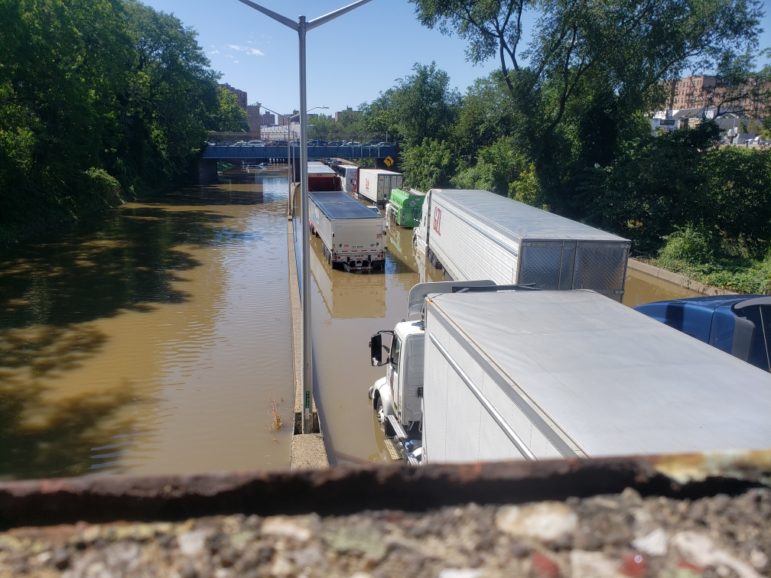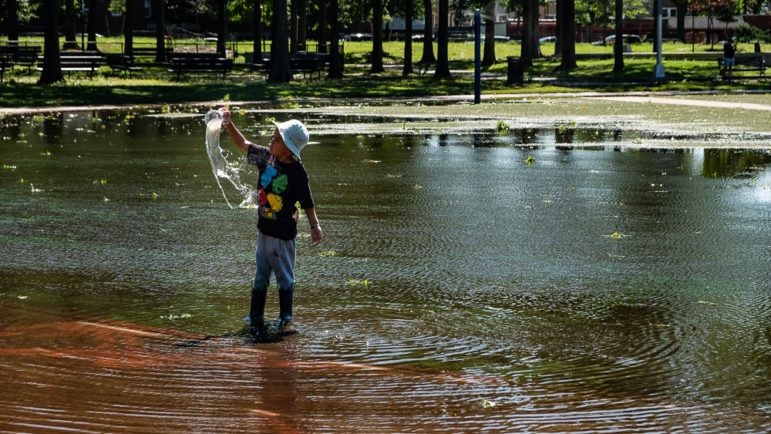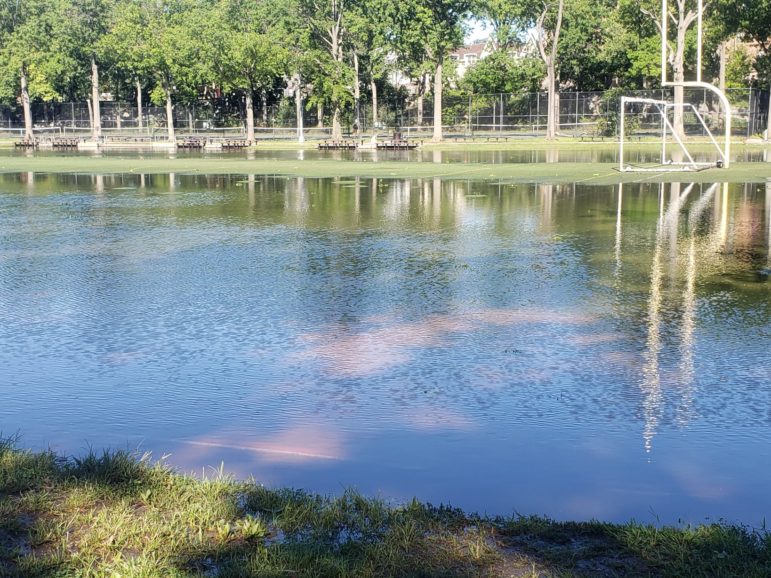Flash floods from historic rains Wednesday night killed nine New Yorkers, eight of whom died in basements of residential homes, officials said Thursday. Mayor Bill de Blasio and Gov. Kathy Hochul said their administrations are assessing the damage and preparing for a “whole new world” of extreme weather.

Jarrett Murphy
Trucks flooded along the Major Deegan Expressway near 234th Street in the Bronx.This story has been updated from its original version to include new information.
Record-breaking rains fell on New York Wednesday night, causing flash floods, power outages and other dangerous conditions across the region and left nine people dead—marking what elected officials described as a “whole new world” for extreme local weather events.
The storm, remnants of Hurricane Ida that struck the Louisiana coastline earlier in the week, brought the city’s subway system to a standstill. Images circulating on social media showed massive amounts of water pouring into underground train stations, as well as flooding in residents’ homes and cars on city streets that were trapped or floating in murky floodwaters.
“We are in a whole new world now, let’s be blunt about it. We saw a horrifying storm last night, unlike anything we have seen before,” Mayor Bill de Blasio said during a press briefing Thursday morning, noting that Wednesday was the second batch of record-setting rain the city experienced in the last two weeks.
NYPD officials said that of the nine people killed in the floods, eight were in Queen. Eight of those victims were killed in the basements of homes, while the ninth was found dead Thursday morning in the backseat of a car on the Grand Central Parkway.
“We pray that the number does not go up from there,” Police Commissioner Dermot Shea said.
Weather forecasters had initially predicted three to six inches of rain over the course of the day, the mayor said—”not a particularly problematic amount.”
“That turned into the biggest single hour of rainfall in New York City history, with almost no warning,” he said. “So now we’ve got to change the ground rules. From now on what I think we do is tell New Yorkers to expect the very, very worst. It may sound alarmist at times, but unfortunately it’s been proven by nature.”
Actual rainfall from the storm was as much as nine inches on Staten Island; Central Park saw more than seven inches, and parts of Queens got nearly the same, according to the National Weather Service.
“Rainfall rates were really extraordinary and far exceeded the capacity of the system,” said Vincent Sapienza, commissioner of the city’s Department of Environmental Conservation. “Anything over two inches an hour, we’re going to have trouble with.”
Some, though, have criticized city and state leaders for not being better prepared, pointing out that meteorologists were forecasting intense rains as early as Monday. The City Council will hold an oversight hearing on Sept. 14 to examine the de Blasio administration’s planning and response to the event.
“What happened on Wednesday raises several urgent questions, including why we weren’t better prepared for an anticipated storm,” Councilmembers Corey Johnson, Justin Brannan, James Gennaro and Ydanis Rodriguez said in a join statement announcing the hearing.
When it comes to the subways, Hochul said the flooding from Ida differed from past extreme weather events like Hurricane Sandy in that it wasn’t caused by coastal storm surges but from an overwhelmed sewage system.
“We learned a lot of lessons from Sandy. We built back resiliency, our coastal shorelines are in much better shape than they had been, but where we have a vulnerability is in our streets,” the new governor said, saying it will be essential that the city and state focus next on addressing “drainage shortcomings.”
“Because when the streets get flooded, what happens next? The water rushes down, not just through the highways, but also finds its way to penetrate our subway system, and as a result, what happened yesterday, trains were shut down, people were stranded,” Hochul explained.
“That says to me that there are no more cataclysmic, unforeseeable events. We need to foresee these in advance and be prepared,” she said.
Scientists have been sounding the alarm for decades about the increasingly extreme weather. Most recently, on Aug. 9, the Intergovernmental Panel on Climate Change released a grim report predicting increased frequency and intensity of storms—becoming more severe with each .5 degree Celsius global warming above pre-industrial temperatures.
“For cities, some aspects of climate change may be amplified, including heat (since urban areas are usually warmer than their surroundings), flooding from heavy precipitation events and sea level rise in coastal cities,” the report noted.
A state of emergency was still in effect Wednesday for the five boroughs and neighboring counties on Long Island and upstate New York. Hochul said she had spoke with President Joe Biden, who pledged to support the region’s recovery with Federal Emergency Management Agency (FEMA) funds.
“We’ll be doing on the ground assessments of the damage with the FEMA teams,” Hochul said, estimating that damages from the storm will exceed $30 million. Beyond the immediate recovery needs, lawmakers also stressed the need for more federal funds to fortify and update the city’s aging infrastructure.
“I don’t think it’s too little too late. I think it would have helped us a hell of a lot more a few decades ago, but we’re going to be playing a lot of catch up,” de Blasio said. “We’re talking not billions, [but] tens of billions, even hundreds of billions, to really be able to make people safe.”












